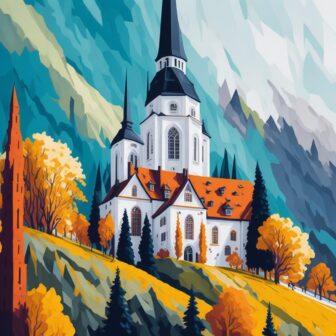14 Most Beautiful Churches and Cathedrals in Germany (2023)
In the past centuries, the churches and cathedrals in Germany were much more than a place for prayer, worship and teaching. They represented the cultural and urban center of places.
Today, the places of worship are also popular travel destinations in Germany, because the churches and cathedrals in Germany are impressive testimonies to earlier architecture and often small miracles of technology.
I will tell you here which churches in Germany you absolutely must have seen on your next holiday in Germany. Discover their exciting stories and pause for a moment. The impressive art of the buildings is also accessible to you regardless of your religion.
Frauenkirche in Dresden
It is the landmark and a popular sight in Dresden and probably represents the reconstruction of many places of worship after the Second World War like no other church in Germany.
During the air raids on Dresden in World War II, the church was almost completely destroyed and rebuilt between 1994 and 2005.
Inside the church you will find the original altar today, which survived the war with some damage.
The war damage was deliberately left at the core of the altar. So it forms a raw counterpart to the other furnishings in the Baroque style.
The evangelists and the four Christian virtues of faith, hope, love and mercy are shown in a total of eight paintings in the dome vault.
Cologne Cathedral
It is one of the most popular sights in Germany and one of the most impressive sacred buildings in Germany: the Cologne Cathedral.
The foundation stone for Cologne Cathedral was laid in 1248. However, it was not completed until 1880.
Although almost all architectural styles of the past centuries can be found on the church, experts see it as a uniquely successful church building that perfectly combines all styles.
Until 1884, Cologne Cathedral was the tallest building in the world. The predecessor of the Cologne Cathedral became an important place of pilgrimage in the early years, because the supposed relics of the Three Kings are kept here.
The shrine of the Three Kings is placed in the center of the choir room and is considered to be the largest medieval goldsmith’s work. It is decorated with many pictures and precious stones and pearls.
Cologne Cathedral has been a UNESCO World Heritage Site since 1996.
Insider tip:
In order to capture the large cathedral and its many exciting highlights, you should take part in a guided tour.
RELATED:
Best Places to Visit in Cologne
Berlin Cathedral
The next beautiful church in Germany can be found in the German capital Berlin on the Spree Island.
As early as the 15th century there was a church on the Spreeinsel, which over the years has been continuously modified and expanded to adapt it to the circumstances.
Today’s cathedral was built in 1894 after lengthy construction delays and was completed in 1905. After the Berlin Cathedral suffered considerable damage in World War II, it was rebuilt from 1975.
Inside the almost square building you will find a Sauer organ from 1905, and you can also look up into the church dome.
There is a Holy Spirit window in the middle, mosaics with the Beatitudes and a relief with scenes from the Acts of the Apostles.
Today, the Berlin Cathedral also functions as a venue for high-profile political events such as ceremonies or state acts.
Aachen Cathedral
Aachen Cathedral was built at the behest of Charlemagne and looks back on 1200 years of history. From 936 to 1531 the cathedral was the coronation site of the Roman-German kings.
Although many architectural styles have influenced the exterior of the church over time, it is still considered the most important example of the Carolingian Renaissance.
It is part of the UNESCO World Heritage and houses a large number of important art objects that are exhibited in the cathedral treasury.
Among the exhibits shown there is the Proserpina sarcophagus. Charlemagne is said to have been buried in this marble coffin in Aachen Cathedral after his death in 814.
The exhibition in the cathedral treasury is divided into the areas of Charlemagne, liturgy, coronations, veneration of the Virgin Mary, pilgrimage and treasure of relics.
Erfurt Cathedral
The nearest German church can be found in the beautiful city of Erfurt. Here, the ensemble of Erfurt Cathedral and the Severi Church characterizes the cityscape of the Thuringian state capital.
A first church is said to have stood on the site of today’s cathedral as early as 752. The building was first mentioned in 1117.
Today you can see the stained glass windows in the church from the Middle Ages and the interior of the choir, which has largely been preserved in its original state.
The high altar has also been preserved. It was made between 1997 and 1707.
The ringing of the church includes a total of 13 bells. One of them, the Gloriosa, is the largest free-swinging medieval church bell in the world.
Hamburger Michel
The Hamburg Michel is actually called the Hauptkirche Sankt Michaelis, but this name is hardly ever used. It is one of the sights of Hamburg and the landmark of the port city.
The Michel is considered the most important baroque church in northern Germany and is dedicated to Archangel Michael.
A church is said to have stood on the site of today’s Michel as early as the year 600. The Michel is already the third sacred building at this location. After a fire in 1906, the church was completely rebuilt.
The interior of the brick church is flooded with light and the vaulted ceiling shines in bright white. A special highlight is the church tower, which is around 132 meters high and has always been an important landmark for ships heading for Hamburg.
From the visitor platform at a height of 83 meters you can enjoy a sweeping view of the city of Hamburg.
Bamberg Cathedral
The Imperial Cathedral of Bamberg impresses from the outside with its four towers and is slightly elevated on the Domberg in Bamberg.
The cathedral is best known for the Bamberger Reiter, an equestrian statue inside the church from the first half of the 13th century. The history of the cathedral goes back to the year 1004, when Emperor Heinrich II laid the foundation stone for the first cathedral. However, this building was destroyed by a fire in 1081.
Today, Bamberg Cathedral is not just a popular tourist destination. Inside the church you will find a large number of historical figures, impressive choirs and magnificent furnishings.
The tomb of Pope Clemens II is particularly worth seeing. It is the only surviving tomb of a pope north of the Alps.
Another impressive tomb inside the church is the Imperial Tomb. There lie Emperor Heinrich II and Empress Kunigunde.
Bamberg is one of the most beautiful cities in Germany.
Bonn Minster
The next beautiful church of Germany that we would like to introduce to you is the Bonn Minster. It was built as a Romanesque collegiate church as early as the 11th century. However, finds indicate that there was already a place of worship here in Roman times.
The church combines Gothic and Romanesque style elements, the interior of the church comes mainly from the Baroque period and the last centuries. In this way, all elements and styles in the Bonn Minster come together to form a suitable overall package.
Inside the Bonn Minster you will find two marble altars from the 17th and 18th centuries and a bronze statue of Saint Helena. In the 11th-century crypt, you can visit a replica of a historic shrine. The original was stolen in 1587, along with most of the church treasury.
Insider tip:
Every year during the city patron festival on October 10th you can visit the crypt of the Bonn Minster. The Christian martyrs Cassius and Florentius as well as Malusius are said to have lain here.
RELATED:
Best Places to Visit in Bonn
Ratzeburg Cathedral
The silhouette of the Ratzeburg Cathedral rises up on the old town island of Ratzeburg. The brick church was built from 1160 and is an important testimony to Romanesque brick architecture.
Inside the church you will find the oldest choir stalls in northern Germany and the high altar from 1629 and the epitaph created in 1649 have been preserved. It shows August von Sachsen-Lauenburg and his wife Countess Catharina zu Oldenburg and Delmenhorst.
Other old treasures are the carved winged altar from the late Gothic period and the magnificent Renaissance pulpit from 1576.
Castle Church in Wittenberg
Not only because of its architecture, but also because of its historical significance, it is one of the most beautiful churches in Germany.
It was in the Castle Church in Wittenberg that Martin Luther nailed his 95 theses to the door on October 31, 1517.
The then wooden door was used by the scholars and members of the university to post information and make it known to the population and other scholars. Unfortunately, the door fell victim to the flames during the Seven Years’ War.
Today you can admire a bronze door from 1858. It was donated by King Friedrich Wilhelm IV on the occasion of Luther’s 375th birthday. The text of the theses can be read on it in Latin script.
As early as 1340, a castle and a church were built on the site of today’s castle church. The Castle Church has been a UNESCO World Heritage Site since 1996.
Another place where Martin Luther worked was the Wartburg. It is still one of the most beautiful castles and palaces in Germany.
Elisabeth Church in Marburg
From 1235 the Elisabeth Church in Marburg was built at the foot of the Schlossberg.
It was built over the grave of Saint Elizabeth of Thuringia, making it an important place of pilgrimage in the late Middle Ages.
The Elisabeth Church is the first purely Gothic church in the German cultural area. Until the 16th century, the church was the burial place of the Landgraves of Hesse.
Incidentally, you will no longer find the bones of Saint Elizabeth in the church today. In order to set an example against the cult of relics, the then Landgrave removed all relics from the church in 1539.
Today you can find them in monasteries and museums all over Europe.
Speyer Cathedral
Speyer Cathedral is the largest preserved Romanesque church in the world and is one of the most beautiful sights in our country.
The cathedral has been a UNESCO World Heritage Site since 1981 and is the main attraction of Speyer’s old town.
From its church tower you have a great view over Speyer and the region. On the way up to the church tower you will pass the Kaisersaal. It is above the entrance portal of the cathedral.
In the hall there are nine monumental frescoes by the painter Johann Baptist Schraudolph, which used to be on the walls of the transept.
When the cathedral was renovated, they were dismantled and stored. Since 2012 you can marvel at them in the Kaisersaal.
Another sight is the crypt from the year 1041. It is located under the cathedral and can be entered.
RELATED
Ulm Minster
The Ulm Minster is the largest evangelical church in Germany and has the tallest church tower in the world.
This rises an incredible 161.53 meters into the sky and was completed in 1890.
The foundation stone for the church was already laid in 1377, when Ulm became a free imperial city and was still Roman Catholic.
It was not until 1530 that Ulm became Protestant and so did the Gothic church.
The portals of the church are particularly worth seeing. They show detailed depictions of the Last Judgment, the story of creation, including a god with a round earth and other planetary balls.
Inside the church you will find more detailed art treasures, pulpit, windows and organs.
Gustav Adolf Stave Church in Goslar
The last church that made it onto the list of the most beautiful churches in Germany is visually very different from the other churches presented.
From 1907 to 1908 the church was built on the model of a stave church. This church construction method was mainly used in the Scandinavian countries, but also in northern Germany at the beginning of Christianization.
The bar structure is a supporting structure made of vertical masts on which the entire roof construction rests.
The original stave churches often still have pagan symbols such as dragon heads or snake symbols. This was adopted in the Goslar stave church.
The interior of the church is also made entirely of wood and offers space for around 50 people.
You will find many ornaments on the walls and ceilings of the church.
By the way: The stave church is not far from the Harz National Park. It is one of the national parks in Germany.
14 Most Beautiful Churches and Cathedrals in Germany
- Frauenkirche in Dresden
- Cologne Cathedral
- Berlin Cathedral
- Aachen Cathedral
- Erfurt Cathedral
- Hamburger Michel
- Bamberg Cathedral
- Bonn Minster
- Ratzeburg Cathedral
- Castle Church in Wittenberg
- Elisabeth Church in Marburg
- Speyer Cathedral
- Ulm Minster
- Gustav Adolf Stave Church in Goslar






